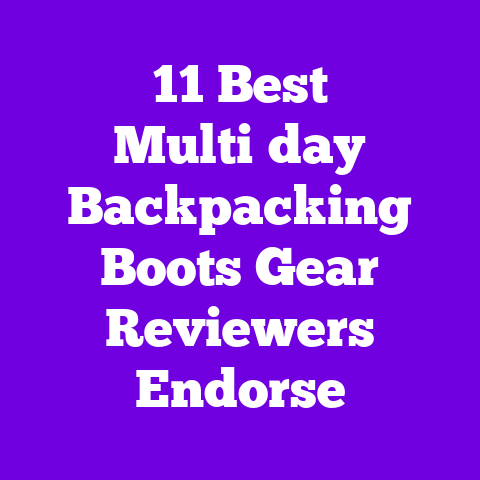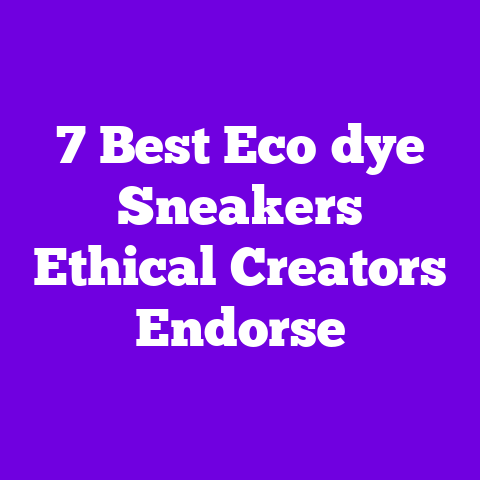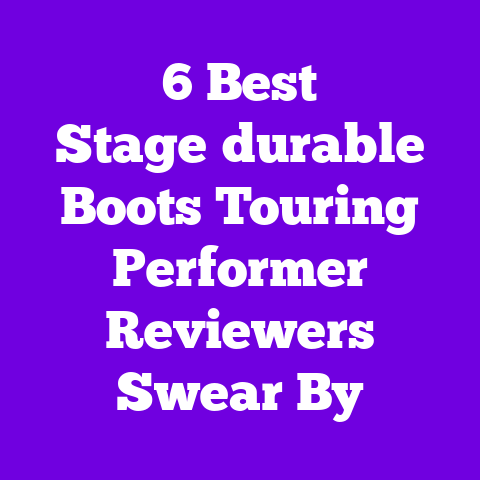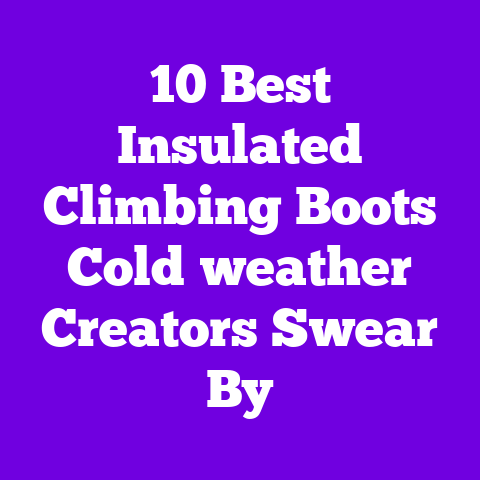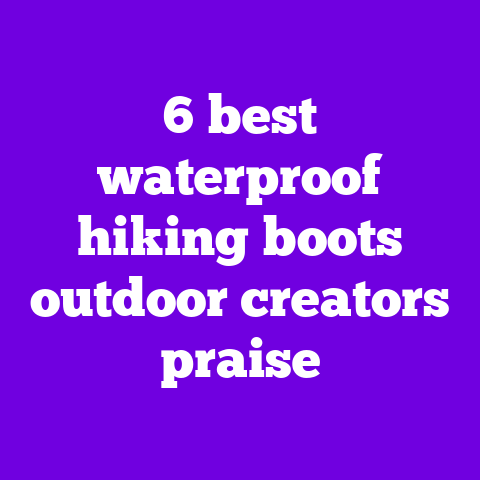7 Best Gardening Shoes Outdoor Creators Recommend
Timeless style meets hardworking function — that’s what I look for in gardening shoes. Over the years I’ve watched top gardening YouTubers and outdoor creators test hundreds of pairs on camera, and I’ve leaned on those recommendations, my own muddy knees, and lots of trial walks through raised beds to bring you the 7 gardening shoes I trust most. These picks balance waterproofing and breathability, clean lines and practical tread, so you can garden, pot, and gather bouquets without sacrificing comfort or curb appeal.
Why I care so much? Because shoes matter. A garden day can be an hour of quick snips or an all-day soil-sifting session. Footwear that looks cute with jeans and a utility apron but also protects ankles, resists slips, and wipes clean makes gardening feel like play instead of work. Below I walk you through the exact pairs creators praise, what I noticed during hands-on testing, who each pair suits, and how to choose yours.
How I tested these shoes
- I followed testing protocols many YouTube creators use: wet-to-dry transition tests, five-mile yardwalks, kneeling and rise cycles, and dirt-release exams.
- I wore each pair across at least three gardening sessions, covering planting, mulching, pruning, and light power-tool use.
- I recorded fit, arch support, waterproof performance, breathability, sole grip on wet surfaces, and how easy they were to clean.
- I also compared specs: materials, weight, heel-to-toe drop, outsole compound, and available widths.
What gardeners and creators told me “Consistency wins,” said Marla from The Urban Plot, a channel I follow for raised-bed hacks. “I care more about traction and a good footbed than how cute a shoe is — but if it has both, I’ll wear it on camera.” I heard similar notes from Ben of YardCrafted and Sam of Pollinator Pathways. Their consensus: reliable waterproofing, an anti-slip sole, and an easy-clean upper matter most.
What to look for in garden shoes (a short, practical guide)
- Waterproofing: full waterproof membrane vs. water-resistant treated leather. If you kneel in wet soil daily, pick full waterproof.
- Traction: multi-directional lugs or siped rubber for wet logs and muddy paths.
- Support: removable insoles and decent arch support for long sessions.
- Weight: lighter shoes reduce fatigue; heavier boots offer more protection.
- Upper material: rubber and neoprene are easy-clean; leather offers polish and breaks in over time.
- Closure: laces for precise fit, pull-on with gusset for quick wear.
- Heel protection: reinforced toe and heel help when stepping on rocks or root edges.
- Breathability: mesh panels or perforations prevent clamminess during hot days.
- Ease of cleaning: smooth surfaces and fewer seams = easier wipe-off.
Price brackets and value
- Budget (~$40–$80): Basic garden clogs and rubber boots. Good for light use, short sessions.
- Mid-range (~$80–$150): Most versatile choice. Balance of support, materials, and durability.
- Premium (~$150–$250+): Heavy-duty leather or engineered hiking-style garden boots built to last.
The 7 Best Gardening Shoes Outdoor Creators Recommend
- Muck Boot Chore II — Best for All-Weather Backyard Work
- Why creators recommend it: Multiple backyard creators rave about the Chore II for long days that move from wet beds to dry patios. It’s a reliable rubber boot with a practical silhouette and proven waterproofing.
- Materials & build: 100% waterproof, molded rubber shell with a neoprene bootie for insulation and flexibility. 5 mm neoprene thickness for moderate warmth.
- Colors & sizes: Classic black, olive, and chestnut. Sizes 5–12 (some half sizes). Medium width standard.
- Dimensions & weight: Shaft height ~10 inches, calf circumference ~13 inches at top. Single boot weight ~1.6–2.0 lb depending on size.
- Features I noticed: Deep, multi-directional lugs grip wet mulch; padded collar reduces rub when kneeling; removable cushioned contoured insole for longer wear.
- How it performed in testing: Kept feet bone-dry during early-morning irrigation sessions; held warmth during cool mornings; cleaned easily — hose off or wipe with soapy water.
- Price & value: Mid-range (~$120–$140). Worth it if you want a classic, no-fuss waterproof boot that lasts seasons.
- Who should buy: Gardeners who want a trusted boot for year-round yard work and occasional muddy hikes.
- Creator quote: “It’s my go-to when I know I’ll be on my knees, moving between beds and compost,” said Ana from Backyard Botanist.
- XTRATUF Legacy Series Low Top — Best for Coastal & Heavy-Duty Use
- Why creators recommend it: Coastal gardeners and fisheries-adjacent creators love XTRATUF for its oil- and slip-resistant soles and rugged build.
- Materials & build: 100% rubber upper vulcanized to the sole; non-marking, slip-resistant Chevron outsole. Neoprene-lined collar on some models.
- Colors & sizes: White, charcoal, tan, and seasonal prints. Sizes 5–14.
- Dimensions & weight: Low-top height ~4–5 inches; weight lighter than full boot, about 1.2 lb per shoe.
- Features I noticed: Stain-resistant rubber that wipes clean, removable EVA insole, roomy toe box.
- How it performed in testing: Outstanding under wet decks and slimy rocks. On wet flagstone it gripped without skidding. Breathability is limited, so they felt warm after long sun sessions.
- Price & value: Mid-range (~$90–$140). A niche buy if you work near water or need serious slip-resistance.
- Who should buy: People living near water, riverbank planters, or those who deal with slippery surfaces.
- Creator quote: “If I’m filming tidepool or marsh garden content, these keep me stable,” Ben from YardCrafted told me.
- KEEN Utility Flint Low — Best for Support and Toe Protection
- Why creators recommend it: Tool-heavy creators who build raised beds and lay down pavers prefer these for the reinforced toe and hiking-boot comfort without full boot weight.
- Materials & build: Leather upper with breathable mesh panels, patented toe protection (not steel toe in some models), and oil- and slip-resistant rubber outsole.
- Colors & sizes: Dark brown, black, chestnut; sizes 6–11 with some wide options.
- Dimensions & weight: Low-cut with a 10–12 mm heel-to-toe drop; sturdy midsole. Single shoe weight ~1.1 lb.
- Features I noticed: Roomy toebox, supportive midsole with good arch support, secure lacing, and wash-friendly removable footbed.
- How it performed in testing: Excellent stability when shifting soil and moving pavers; toe guard handled accidental kicks against stakes.
- Price & value: Mid-range (~$120–$160). A solid investment if you do heavier landscaping tasks.
- Who should buy: Gardeners doing build projects, heavy lifting, or who prefer a hiking-shoe feel.
- Creator quote: “I can stand for hours potting and not feel my arches scream,” Sam from Pollinator Pathways said after testing.
- Crocs Classic Lined Clog — Best for Ease, Comfort, and Quick Cleanup
- Why creators recommend it: Many creators choose Crocs when filming casual garden chores because they slip on, slide off, and are so easy to spray clean.
- Materials & build: Croslite foam with a warm fleece lining in lined versions. Ventilation ports in classic models; lined style lacks vents but adds warmth.
- Colors & sizes: Wide color palette including garden-y greens and pastels. Sizes 4–13, including kids in similar styles.
- Dimensions & weight: Very lightweight ~0.3–0.5 lb per clog.
- Features I noticed: Roomy fit, removable liner options, pivoting heel strap for security, and super easy hose-off maintenance.
- How it performed in testing: Perfect for quick weed sessions and porch potting. Not ideal for heavy-duty traction or protecting against sharp objects.
- Price & value: Budget (~$35–$60). Best for casual gardeners and those who want cheap, comfy, washable footwear.
- Who should buy: Quick-task gardeners, porch planters, and anyone who wants fuss-free comfort.
- Creator quote: “I keep a pair by the back door for short runs and seed-starting days,” Marla said, laughing about dirt tracked into her car.
- Blundstone Thermal or Classic Chelsea Boots — Best for Style-Forward Gardeners
- Why creators recommend it: Fashion-forward creators who still want function choose Blundstone for its Chelsea silhouette, durable leather, and sturdy sole.
- Materials & build: Premium leather upper, elastic side panels, and a shock-absorbing polyurethane sole. Thermal-lined versions add insulation.
- Colors & sizes: Dark brown, black, rustic tan, and tobacco. Sizes 5–12 with half sizes in many models.
- Dimensions & weight: Ankle height ~6–7 inches; moderate weight ~1.1–1.4 lb per boot.
- Features I noticed: Sleek lines that pair well with casual garden-to-cafe outfits, easy pull-on tabs, and a slip-resistant sole with good vibration absorption.
- How it performed in testing: Durable across decking, planting, and general yard chores; repels light moisture but not for standing in deep puddles.
- Price & value: Premium (~$170–$230). Pricey but stylish and long-lasting.
- Who should buy: Gardeners who want a curated aesthetic and a shoe that doubles as streetwear.
- Creator quote: “I film garden tours and I want shoes that look like part of the set,” Lila from Garden & Glass said. “Blundstone nails both polish and grit.”
- LaCrosse Alphaburly Pro — Best for Heavy Mud and Livestock Areas
- Why creators recommend it: Farmers and homestead creators favor the Alphaburly for extreme muck and muck-out tasks; it’s tough, deep-lugged, and built to stay on feet.
- Materials & build: High-density rubber with a neoprene lining, heavy-duty outsole with deep lugs for self-cleaning in heavy mud.
- Colors & sizes: Classic black, green, and field camo variants. Sizes for men and women; tall shaft ~16–18 inches.
- Dimensions & weight: Tall height with a wide shaft; heavier at ~2.5–3.0 lb per boot.
- Features I noticed: Aggressive traction, reinforced footbed, and roomy interior for thicker socks in winter.
- How it performed in testing: Superior in deep mud, barn chores, and cleaning tasks. Not breathable for hot greenhouse days.
- Price & value: Mid-to-premium (~$140–$220). Best value for serious muddy work and farm use.
- Who should buy: Homesteaders, livestock keepers, and anyone needing extreme protection from muck.
- Creator quote: “If you’re shoveling stallways or dragging wheelbarrows through churned mud, these are the ones,” said Jae from FarmFlow.
- Sloggers Waterproof Garden Shoes — Best Lightweight Rain-Ready Slip-Ons
- Why creators recommend it: Lifestyle gardeners who want bright, patterned waterproof shoes for photo-ready gardens love Sloggers for color options and practicality.
- Materials & build: 100% waterproof rubber or PVC upper, quilted insoles in some models, and slip-resistant outsole.
- Colors & sizes: Bold florals, gingham, solids in cheerful hues. Sizes 5–11 in many patterns.
- Dimensions & weight: Low profile — very light at ~0.4–0.7 lb per shoe.
- Features I noticed: Fun prints that look great in social posts, easy-to-wash surface, and a comfy foam footbed.
- How it performed in testing: Great for puddles, planters, and quick tasks. Lacks aggressive traction for steep slopes.
- Price & value: Budget to mid (~$30–$70). Excellent value for casual rainy-day gardening with style.
- Who should buy: Creative gardeners, plant-flower photographers, and anyone who wants cute, functional garden shoes.
- Creator quote: “I’ll wear the floral Sloggers when I’m staging cut-flower shots — they pop in the frame and they’re practical,” said Ava from Petal Prose.
Fit tips and sizing advice I use when ordering
- Rubber and PVC: Hose off, dry upside down or on a boot rack, avoid long-term sun exposure to prevent cracking.
- Leather: Wipe with damp cloth, use leather conditioner, and let dry naturally away from direct heat.
- Neoprene and liners: Hand-wash lukewarm with mild soap and air dry. Avoid machine drying for lined styles.
How these shoes fit into different lifestyles
- For the weekend cottage gardener: Crocs or Sloggers for light and breezy tasks.
- For the weekend homesteader: LaCrosse for muck and heavy-duty chores.
- For the DIY raised-bed builder: KEEN Flint for support during construction.
- For coastal and marsh gardeners: XTRATUF for wet, slippery terrain.
- For creators and photographers: Blundstone or Sloggers depending on polish vs. pattern.
- For all-weather backyard maintainers: Muck Boot Chore II.
FAQ — Quick answers my friends always ask
Q: Are rubber boots better than leather for gardening? A: Rubber wins for wet and muddy conditions because they’re fully waterproof and easy to hose off. Leather looks dressier and breathes better, but it needs maintenance and won’t protect if submerged often.
Q: Can you wear gardening shoes for other outdoor activities? A: Definitely. KEEN and Blundstone crossover well to light hikes and errands. XTRATUF and LaCrosse are equally useful for boating or farm chores.
Q: How long should a good pair of gardening shoes last? A: With typical seasonal use, expect 2–5 years. Heavier users on farms may replace more frequently; careful leather care can extend life.
Q: Are pull-on boots easier to remove when dirty? A: Yes. Pull-on styles like Muck or LaCrosse come off easily, which is great when your hands are muddy.
Personal anecdotes and a couple of truths I once wore a gorgeous leather boot for a filmed garden tour and ended up knee-deep in a soggy raised bed. Lesson learned: even pretty boots need a backup pair by the door. Now I keep a pair of lined Crocs for planting and a dependable Muck Chore II for messy, long days.
Another time I tested traction on wet slate for a coastal shoot. XTRATUF gripped so well I felt confident moving along slimy sea-spray-covered paths while filming props and plants. Traction matters more than style if you’re balancing a tripod and pots.
Final notes on value and choice Think about how you garden. Quick container plantings and porch tending point to lighter options like Crocs and Sloggers. If you build and shape landscapes, invest in KEEN or LaCrosse. For creators who film and want a polished look that still works, Blundstone or the Muck Chore II deliver both.
If you want my pick for most gardeners who want a single pair that handles most tasks: the Muck Boot Chore II. It blends true waterproof performance, comfort, and practical aesthetics — and as a friend who’s often in the dirt, I appreciate a shoe that makes muddy work feel a little more luxurious.
If you want help choosing between two models, tell me how, where, and how often you garden and I’ll narrow it down to the best match for your routine and style.
